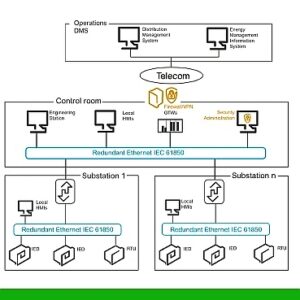 In the ever-evolving landscape of energy infrastructure, where seamless communication and interoperability are paramount, the IEC 61850 standard emerges as a revolutionary force. This exploration delves into the intricacies of IEC 61850, shedding light on its significance, functionalities, and pivotal role in shaping the future of grid communication.
In the ever-evolving landscape of energy infrastructure, where seamless communication and interoperability are paramount, the IEC 61850 standard emerges as a revolutionary force. This exploration delves into the intricacies of IEC 61850, shedding light on its significance, functionalities, and pivotal role in shaping the future of grid communication.
IEC 61850, formally known as the International Electrotechnical Commission standard for Communication Networks and Systems in Substations, is a comprehensive standard that defines the communication requirements and protocols for substation automation systems. Envisioned to foster interoperability and seamless communication in power grids, IEC 61850 sets the stage for a new era in energy infrastructure.
Key Components of IEC 61850
1- Substation Configuration Language (SCL)
At the heart of IEC 61850 is the Substation Configuration Language (SCL), a standardized representation of substation data and communication configurations. SCL ensures consistency and compatibility across various devices and systems, fostering a unified approach to substation design and management.
2- Generic Object-Oriented Substation Event (GOOSE)
GOOSE messaging is a fundamental aspect of IEC 61850, enabling fast and reliable communication for real-time events within substations. This publish/subscribe mechanism facilitates the rapid exchange of critical information, enhancing the responsiveness of protection and control systems.
3- Sampled Values (SV)
IEC 61850 introduces Sampled Values, a standardized method for transmitting analogue signals in digital form. This innovation ensures the high-fidelity transfer of sensor data, enhancing the accuracy and reliability of measurements within substations.
4- Communication Services
The standard defines a set of communication services, including client/server communication, reporting, and logging services. These services establish a common framework for data exchange and coordination, laying the groundwork for efficient and standardized communication in substations.
5- Logical Nodes and Device Models
IEC 61850 is the concept of logical nodes and device models, providing a standardized way to represent various functions and equipment within substations. This ensures a consistent and interoperable approach to configuring and managing devices from different manufacturers.
Advantages of IEC 61850
1- Interoperability
One of the primary benefits of IEC 61850 is its focus on interoperability. By giving a standardized framework for communication and data exchange, the standard enables seamless integration of devices and systems from different manufacturers, fostering a vendor-neutral environment.
2- Enhanced Flexibility and Scalability
IEC 61850’s standardized approach allows for enhanced flexibility and scalability in substation design. The use of SCL facilitates easy configuration and adaptation to changing requirements, ensuring that substations can evolve with technological advancements.
3- Improved Fault Detection and Response
The real-time communication capabilities of IEC 61850, particularly through mechanisms like GOOSE, enhance fault detection and response within substations. The rapid exchange of critical events enables protection systems to respond swiftly, minimizing downtime and potential damage.
4- Simplified Maintenance
The standardized representation of devices and functions using logical nodes and device models simplifies maintenance procedures. Substation personnel can more efficiently configure, monitor, and troubleshoot devices, reducing the complexity associated with heterogeneous systems.
5- Future-Proofing Investments
IEC 61850’s forward-looking design ensures that substations adopting the standard are well-positioned for future advancements in grid communication technology. This future-proofing aspect protects investments and facilitates the seamless integration of new devices and functionalities.
Implementing IEC 61850: Considerations and Challenges
1- Integration with Legacy Systems
One of the challenges in implementing IEC 61850 is integrating the standard with existing legacy systems. While the standard is designed for interoperability, transitioning from traditional communication protocols to IEC 61850 requires careful planning and consideration.
2- Cybersecurity Concerns
As with any networked system, cybersecurity is a critical consideration. Implementing IEC 61850 introduces new cybersecurity challenges that need to be addressed to ensure the integrity and confidentiality of communication within substations.
3- Training and Skill Development
The adoption of IEC 61850 may necessitate training and skill development for substation personnel. Familiarity with the standard’s concepts, configuration methods, and troubleshooting procedures is crucial for efficient implementation and ongoing maintenance.
4- Vendor Support and Compatibility
Ensuring that devices from different vendors are compliant with IEC 61850 and can seamlessly integrate poses a consideration. Collaboration with reputable vendors offering IEC 61850-compliant solutions is vital to overcoming compatibility challenges.
The Role of Reputable Energy Brands in IEC 61850 Implementation
Partnering with reputable energy brands is a strategic decision when embarking on the implementation of IEC 61850. These brands offer several advantages:
Expertise and Guidance
Reputable energy brands bring expertise and guidance to the table. Their experience in the energy sector equips them to provide valuable insights into the intricacies of IEC 61850, ensuring a smooth and informed implementation process.
Interoperable Solutions
Leading energy brands often offer interoperable solutions that seamlessly integrate with IEC 61850. Their commitment to standards compliance and interoperability simplifies the selection and deployment of devices, reducing compatibility concerns.
Cybersecurity Measures
Reputable brands prioritize cybersecurity in their solutions. Partnering with these brands ensures that the implemented IEC 61850 systems incorporate robust cybersecurity measures, safeguarding critical infrastructure against potential threats.
Training and Support
Energy brands with a solid reputation provide comprehensive training and support services. This includes training programs for substation personnel, ongoing support for troubleshooting, and updates to ensure that the IEC 61850 implementation remains optimized.
IEC 61850 stands as a beacon of innovation in the realm of grid communication, offering a standardized approach that paves the way for a more interconnected and efficient energy infrastructure. While challenges exist in its implementation, the benefits of interoperability, flexibility, and future-proofing make IEC 61850 a transformative force in the energy sector.
When navigating this transition, the strategic choice of partnering with reputable energy brands ensures a reliable and well-supported implementation of IEC 61850, ushering in a new era of grid communication and energy management.
Shift Frequency © 2024 – IEC 61850 Standard:
Pioneering the Future of Grid Communication
